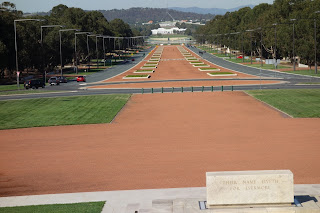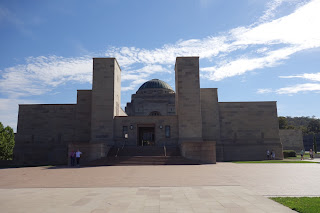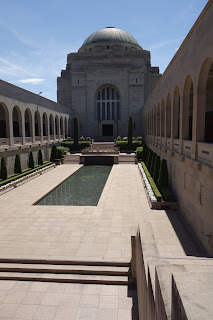The Australian War Memorial is Australia's national memorial to the members of all its armed forces and supporting organizations who have died or participated in the wars of the Commonwealth of Australia. The memorial also includes an extensive national military museum. The Australian War Memorial was opened in 1941, and is widely regarded as one of the most significant memorials of its type in the world.
ANZAC Parade is the broad boulevard out in front of the War Memorial, named in honour of the soldiers of the Australian and New Zealand Army Corps. It stretches from the shore of Lake Burley Griffin to the foot of the Memorial proper, along the line of sight from Parliament House. Along each side of the Parade is a row of monuments commemorating specific military campaigns or services, such as the Vietnam War and Australia's wartime nurses. The monuments are mostly sculptures in a variety of styles ranging from naturalistic to modern. Although I didn't have a chance today, if time permits while I am here in Canberra I will definitely go back and walk along ANZAC Parade, and then hopefully you too will be able to see some of the many sculptures that line this wonderful area.
The Australian War Memorial consists of three parts: the Commemorative Area (shrine) including the Hall of Memory with the Tomb of the Unknown Australian Soldier, the Memorial's galleries (museum) and Research Centre (records). The Memorial also has an outdoor Sculpture Garden.
Charles Bean, Australia's official World War I historian, first conceived a museum memorial to Australian soldiers while observing the 1916 battles in France. This building however, was not completed until 1941, after the outbreak of World War II. It was officially opened following a Remembrance Day ceremony on 11 November 1941.
The sculpture garden on the lawns of the Memorial contain a variety of outdoor monuments. The sidewalk through the garden is embedded with bronze plaques commemorating various branches of service, specific units, and historical events, and there are also several sculptures throughout the lawn area. One in particular is of "Simpson and His Donkey". John Simpson Kirkpatrick enlisted in the 3rd Australian Field Ambulance as Private Simpson in 1914. He took part in the landing in Gallipoli in 1915 and became famous among Australian troops for his bravery and compassion. Under continual shell-fire he used a donkey to carry water up Shrapnel Gully, and to bring wounded men down to the beach on Anzac Cove from the firing line on the ridges above. After less than 4 weeks in action he was fatally wounded. Although he was known on Gallipoli by a variety of nicknames, most of the soldiers who witnessed his bravery knew him simply as the man with the donkey, without ever learning his name. Simpson has come to embody for Australians the spirit of self-sacrifice in war.
The heart of the commemorative area is the Hall of Memory, a tall domed chapel with a small floor plan in the form of an octagon. The walls are lined with tiny mosaic tiles from the floor to the dome. Inside lies the Tomb of the Unknown Australian Soldier.
In front of the Hall of Memory is a narrow courtyard with a memorial pool surrounding an eternal flame and flanked by sidewalks and shrubbery, including plantings of rosemary for remembrance. Above the courtyard to either side are long cloisters containing the Roll of Honour, a series of bronze plaques naming the 102,000 Australian servicemen and women killed in conflict. The entire long wall of the western gallery is covered with the names of the thousands who died in World War I. The eastern gallery is covered with the names of those who died in World War II and more recent conflicts. The roll shows the names only, not rank or other awards, as "all men are equal in death". Visiting relatives and friends can insert poppies in the cracks between the bronze plaques, beside the names of their loved ones and those they wish to honour.
The Memorial is a two-storey building with a floor plan in the shape of a cross. One of the wings is dedicated primarily to World War I and the other entirely to World War II. Between the wings lies Aircraft Hall, which contains a number of complete aircraft, mostly from the World War II era. Also between the wings lies the Hall of Valour, a display of 61 of the 96 Victoria Crosses awarded to Australian soldiers; the largest publicly held collection of Victoria Crosses in the world, including all 9 VCs awarded to Australians at Gallipoli. The lower level of the Memorial contains a theatre, a research area, displays for the colonial and post–World War II conflicts, and an area for temporary special exhibitions.
The building is enormous and the collections are extensive! I didn't even try to take any photos of the displays in the Memorial because I know photos will simply not do any of it justice. I was only there for a few hours - one would need several days in order to really see everything that is housed here.










No comments:
Post a Comment